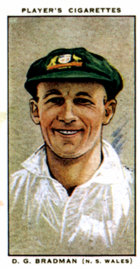The front cover may be a little yellow with age but the booklet is still in pristine condition - one of the treasured possessions of my boyhood: An Album of Cricketers, 1938 issued by John Player and Sons. Costing a penny, it contains the complete set of cigarette card photographs of England and Australia Test players in cricket's golden era, immediately pre-War.
 While
on holiday in Belfast from Glasgow throughout that summer of 1938, my target
was to fill the 50 spaces. Some photographs were more difficult than others
but, by "swapping ciggies" with cricket-fanatical mates, I collected the lot
and when you succeeded, the joy experienced was tantamount to winning the Ashes!
While
on holiday in Belfast from Glasgow throughout that summer of 1938, my target
was to fill the 50 spaces. Some photographs were more difficult than others
but, by "swapping ciggies" with cricket-fanatical mates, I collected the lot
and when you succeeded, the joy experienced was tantamount to winning the Ashes!
To see those Aussies in the flesh was something different. Until then we had only heard or read about the feats of Sid Barnes, Bill Brown, Jack Fingleton, Les Fleetwood-Smith, Lindsay Hassett, Stan McCabe, Eddie McCormick, Bill O'Reilly and, of course, Don Bradman. We heard the Aussies were coming to Belfast. We couldn't believe it! As 11 year-olds in short pants, armed with lunch boxes and autograph books, my pal Raymond and I set out that September day 63 years ago from our Ravenhill Avenue home for Ormeau - and Ireland's match with the Aussies. It was a dream come true.
At last we would see Bradman, whose name spelled magic to us. Disappointment, however, when we learned that he hadn't accompanied the squad to Belfast. Still, there were other stars, so we hovered near the pavilion to catch a glimpse of them coming down the famous steps to walk to the wicket. That John Player album was our Who's Who, our Wisden. "That's Fingleton", "He's Hassett", we had no identification problems. There was a tinge of sadness trudging home that we hadn't seen Bradman play that day. And, unfortunately, I never did see him play.
Bradman had always fascinated me. Here was a true genius. I collected all his books and most of the others written about him; the eight part Australian Broadcasting Commission radio series The Don Declares and the piece de resistance - the elegantly produced two volume The Bradman Albums, his life told through the repository of newspaper clippings from his birth in Cootamundra, the Bowral days, his progress to becoming the ultimate batsman of all time - an average of 99.94 tells it all - and, of course, an Australian icon who played such a major role in the development of a nation.
The possibility of ever meeting Sir Donald - knighted in 1949 - seemed remote. Then, out of the blue, on one of my trips to Australia almost 25 years ago, I was introduced to the great man when he attended a business meeting in an Adelaide hotel. I wanted to produce a pen and paper for his autograph. That wouldn't be etiquette for a journalist and the conversation was not about cricket but business: the Don was a leading stockbroker with massive contacts. Could I throw in a question and switch the subject? Not a chance - you couldn't offend The Master. Just to be in the same room as him, however, was a bit special.
The Don, who died in February past at the age of 92, is no longer with us, yet the memory of this batsman non pareil will live for ever where cricketers meet. He achieved things no mortal man has achieved before. That was Bradman, my Sportsman of the Twentieth Century.
